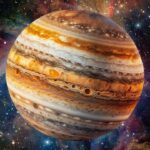
📷 Image Credits: The Indian Express
Astronomers have made an astounding discovery of five young star clusters, possibly the oldest ever found, originating from a time when the Universe was still in its infancy. These massive clusters could provide crucial information about the reionization era of the Universe, according to a team led by Stockholm University and researchers from various European countries, the US, and Japan.
The newly detected star clusters are believed to have formed less than 500 million years after the Big Bang, making them the first of their kind to be unearthed in an infant galaxy. Shedding light on the early stages of star formation, these clusters offer a glimpse into the cosmic past when the Universe was just 460 million years old.
Using advanced technology like the James Webb Space Telescope, astronomers were able to peer back in time and identify these dense and massive clusters within the Cosmic Gems arc, a galaxy that dates back to almost the beginning of the Universe. The discovery marks a significant leap in understanding the evolution of galaxies and star formation in the early cosmos.
In the distant cosmic past, as young galaxies experienced intense periods of star birth, they emitted vast amounts of ionizing radiation, subsequently contributing to the reionization of the early Universe. The detection of these star clusters paves the way for further research into the formation and evolution of galaxies during this critical period.
The findings published in the journal Nature provide direct evidence of proto-globular clusters forming in faint galaxies during the reionization phase, shedding light on the mechanisms that led to the reionization of the Universe. By studying these ancient star clusters, scientists hope to gain insights into the processes that drive galaxy evolution and the formation of massive stars and black hole seeds.
This groundbreaking discovery opens up a new avenue of exploration into the early Universe, offering unprecedented views of star formation processes and the development of galaxies in their infancy. With further observations and analyses planned for the future, astronomers are optimistic about unraveling more mysteries of the cosmos through the study of these massive young star clusters.







